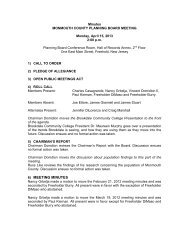NATURAL and CULTURAL FEATURES of MONMOUTH COUNTY
NATURAL and CULTURAL FEATURES of MONMOUTH COUNTY
NATURAL and CULTURAL FEATURES of MONMOUTH COUNTY
You also want an ePaper? Increase the reach of your titles
YUMPU automatically turns print PDFs into web optimized ePapers that Google loves.
Highl<strong>and</strong>s - mostly in Cheesequake State Park in Old Bridge, Conaskonck Point in Union Beach,<br />
<strong>and</strong> the Bayshore Waterfront Park in Port Monmouth <strong>and</strong> Belford. (Reynolds, 2006). During the<br />
1800s <strong>and</strong> early 1900s, tidal flats exposed along the Bay during the lowest spring tides were up<br />
to a mile wide (USGS, 2007).<br />
Bunkers (Atlantic Menhaden)<br />
The first recorded bunker kill in the area was observed by a Dutch settler, Jasper Danckaerts, in a<br />
creek in Staten Isl<strong>and</strong> in 1679 (Waldman, 1999). The largest fishkill on record in the coastal<br />
waters <strong>of</strong> Monmouth County took place in 2000, when 3.9 million juvenile menhaden (peanut<br />
bunkers) suffocated in Little Silver Creek in the Shrewsbury estuary (Reid et al., 2002). While<br />
they are very sensitive indicators for pollution <strong>and</strong> algae blooms, large numbers <strong>of</strong> “bunkers”<br />
also suffocate almost every summer when they are cornered by bluefish <strong>and</strong> other predators.<br />
When they are frightened they defecate <strong>and</strong> pack themselves into tight schools; this uses up all<br />
the remaining oxygen in the warm water where they are trapped by the circling bluefish (known<br />
as a bluefish blitz) (Waldman, 1999). Bunker kills indicate a localized dissolved oxygen (DO)<br />
drop to at least 2.0 mg/l (a good level <strong>of</strong> DO is 5.0 mg/l) (Zimmer, 1996).<br />
“Moss bunkers” is derived from marsbanker or horse mackerel, from the early Dutch settlers;<br />
menhaden are actually members <strong>of</strong> the herring family (Franklin, 2007; Waldman, 1999).<br />
Bunkers are also called shad, fatback, <strong>and</strong> pogie or pogy (not porgy), from "pauhagen," the word<br />
for fertilizer used by the Abenaki tribe <strong>of</strong> Maine (Franklin, 2007). In fact, the Native Americans<br />
<strong>of</strong> Massachusetts may have taught the Pilgrims to use bunkers as fertilizer when planting corn<br />
(Franklin, 2007). Bunkers that are caught commercially, known as reduction fishing, are<br />
“reduced” to fish meal, proteins, <strong>and</strong> oils (including omega vitamins); are used as animal feed<br />
<strong>and</strong> in cosmetics, <strong>and</strong> since colonial days, as fertilizer (Franklin, 2001).<br />
From mid June through the early fall <strong>of</strong> 2007, a record 11 bunker kills occurred in the Bayshore<br />
<strong>and</strong> the Shrewsbury River, 3 estimated in the hundreds <strong>of</strong> thous<strong>and</strong> to million range. Newspaper<br />
pictures showed dead peanut bunker (juveniles) littering the phragmites along Matawan Creek in<br />
Keyport like cherry blossoms, in spite <strong>of</strong> average water quality <strong>and</strong> dissolved oxygen. The only<br />
unusual condition that year was that the water temperature had spiked to 75 o F by Memorial Day<br />
(as recorded at the USGS station at Keansburg), which had contributed to a significant diatom<br />
bloom in S<strong>and</strong>y Hook Bay, the first to occur during the Memorial Day weekend in 10 years. In<br />
2008, bunker <strong>and</strong> other baitfish were predominately spotted by fisherman in the ocean south <strong>of</strong><br />
Long Branch rather than in the Bay. There were only a few minor bunker kills in local estuaries<br />
that year, mostly linked to the bacteria Vibrio ordalii <strong>and</strong> Photobacterium damselae, which cause<br />
respiratory disease in fish, not humans (USFWS Fish Health Center, Lamar, Pennsylvania,<br />
2008).<br />
A 2001 law prohibiting reduction fishing by commercial trawlers within 1.2 nautical miles <strong>of</strong> the<br />
NJ shoreline went into effect in 2002. Bunkers reproduce at age 3, so there have been more than<br />
2 full generations <strong>of</strong> bunkers since then. Since 2005, the numbers <strong>of</strong> bunkers have been<br />
increasing along NJ, <strong>and</strong> have reached the highest level recorded by NOAA from 1985 through<br />
2008 (Eilperin, 2009; Hohn, 2009). The local abundance <strong>of</strong> bunkers may be attracting more<br />
dolphins to the NJ coast, such as the pod <strong>of</strong> 16 that moved into the Navesink <strong>and</strong> Shrewsbury<br />
estuaries from June 2008 until January 2009 (Eilperin, 2009). Rep. Jim Saxton, R-NJ., <strong>and</strong> Rep.<br />
Wayne Gilchrest, R-Md, introduced a bill in 2008 ( H.R. 3840) that would impose a moratorium<br />
<strong>and</strong> would prohibit commercial menhaden fishing in the U.S. Exclusive Economic Zone, which

















